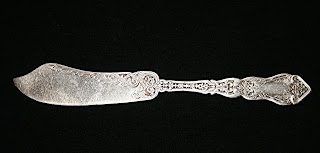There are sugar shells and sugar spoons. Sugar shells are more elaborate and the bowl of the spoon resembles a shell. Sugar spoons may be fancy patterns but the bowl of the spoon is plane like any other spoon with a wider shape at the "mouth" of the bowl. Here are two special examples of sugar shells. The top shell is a monogrammed piece made of coin silver. Coin silver is usually ninety percent silver with another metal mixed in. Pure sterling is very soft and by adding another metal the spoon is more durable. The bottom sugar shell is extremely fancy and is sterling. Sugar shells are meant for dipping sugar from a bowl but any as pretty as these could be used for sauces, nuts or small candies.
Butter knives are just as diverse as sugar spoons. There are individual butter spreaders and there are master butter knives. Individual butter spreaders may be flat handled as the one in the picture or hollow handled. Which ever yours is, they are intended to be placed on the bread and butter plate at each place setting. A butter pat or two should be placed on the bread and butter plate before guests are seated. If not, a master butter plate with a master butter knife is passed and you cut off the amount of butter you wish to have and place it on your bread and butter plate. Then you use your individual butter spreader to butter the bread. A master butter knife is larger than the individual and may have an off-set handle. The master butter knife is used for cutting pats of butter and placing it on your own plate. It is never used to spread butter on your bread. A flat handled butter spreader is five to six inches long and a hollow handled individual butter spreader is a bit larger, six to seven inches. The master butter spreader is also six to seven inches long. You need one individual butter spreader for each place setting in your service but one master butter knife is normal for a flatware set. The master butter knife can also be used for cream cheese.
Welcome to My Blog
Welcome to my blog! My hope is to pass along ideas you will enjoy using in your homes and in your lives. No, I am not Oprah, giving you life advice or Nate Berkus redoing your pantry. My point of view is more practical if not occasionally foo-foo. Decorating should be fun and you should change your decor often. My ideas and vintage finds will help you do just that. Oh, and you may get some fun personal and family stories. We are a small family but we do a lot!
Since I started my blog a couple of years ago, I find I am writing more about "ideas" for your life. Or at least, things that happen in my life! Hopefully I put a smile on your face and help you set your dinner table.
Since I started my blog a couple of years ago, I find I am writing more about "ideas" for your life. Or at least, things that happen in my life! Hopefully I put a smile on your face and help you set your dinner table.


No comments:
Post a Comment